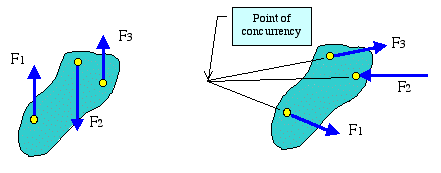Two-Force Members:
|
When only two forces are acting on a member, equilibrium dictates that the two forces be equal in magnitude, collinear, and opposite in direction, as shown in the figure. Otherwise, either the force equilibrium or the moment equilibrium would be violated. Such a member is referred to as a two-force member. We identify two-force members in a built-up structure by the following characteristics:
- No external force or couple moment at any point along its length.
|
 |
Three-Force Members:
|
When only three forces are acting on a member, equilibrium dictates that these forces must be either
We identify three-force members in a built-up structure by the following characteristics:
- Plus at least one force or couple moment at some point along its length. |
 |